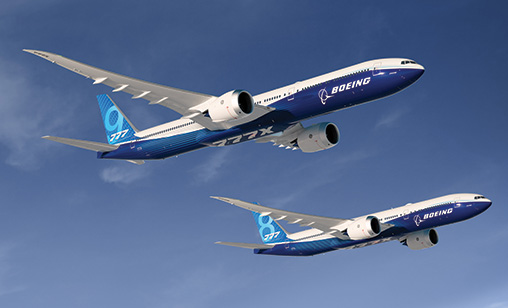News Backgrounder
Thoughts of “chairman Bruns” Boeing’s veteran China hand
Speculation endures about the impact of the Sino-U.S. trade dispute on the China business of Boeing’s commercial aircraft arm. Last month, Orient Aviation’s chief correspondent, Tom Ballantyne, was brought up to date by Boeing’s boss on the Mainland.
February 1st 2019
Asked if there have been signs that U.S. President Donald Trump’s tariff dispute with China is damaging Boeing’s Mainland business, Beijing-based Boeing China president, John Bruns, said: “I’ll give you a data point. Read More » We delivered last year, for the full year, 219 airplanes to China. That’s a record for us and it was done in the middle of all these trade tensions. Obviously the deliveries are our lifeblood. So, from that standpoint the answer would be no.”
Nevertheless, the trade tensions are concerning, he said. “We were encouraged by the good round of talks a couple of weeks ago. They seemed to have gotten both sides back to the table, so we hope those talks will yield some results,” he said last month.
 |
“Obviously, we are a big proponent of free trade. We know there are issues here that need to be resolved and difficulties to be worked through, but we think it is in the best interests of both countries they are resolved.”
If anyone has a feel for the Chinese psyche, it is Bruns. A fluent Mandarin linguist, he has had more than 25 years of experience in the Chinese aviation market. Originally with McDonnell Douglas, he was assigned to its China Program Office in Long Beach before moving to Beijing in 1994 as deputy to the company’s China president.
After the merger of Boeing and McDonnell Douglas in 1997, he joined the Boeing Commercial Airplanes sales organization and led numerous successful aircraft sales campaigns with Chinese airlines and leasing companies. He returned to Beijing in 2007 and was promoted to president of Boeing China in 2016.
“I’ve been working in China for almost my entire career. I grew up here and have been an observer of the U.S.-China relationship for a long time. I am optimistic we have more in common than we have differences. There are so many compelling reasons to find a solution and I am optimistic we will,” he said.
While Washington and Beijing try to resolve the trade dispute at a political level, something else is happening Bruns pointed out. “We do a lot of things by ourselves, but we also are a key member of the U.S.-China Aviation Cooperation program, which is a public/private partnership. We have members from about 42 U.S. companies involved in aviation including Boeing, GE, Textron and Pratt & Whitney, The members supply equipment to airports and systems companies and we all work together to support China on safety, capacity and efficiency initiatives,” he said.
“It has the U.S. government involved in the form of the FAA (Federal Aviation Administration), which participates in various seminars and events that we do in China around safety. It also reflects the fact that while politicians haggle, at an operational level both sides are getting on with the business of aviation.
Bruns said: “We delivered our 2000th airplane [to China] last November. China has benefitted from the rapid growth of its aviation system and they have airlines that are truly world class players. They are profitable and successful. They have an excellent safety record.
“China also is a growing part of our supply chain. We contribute about $1 billion a year to China’s economy through procurement of parts and assemblies, joint ventures and other investments we have made.
“In training, I think the number is 75,000 aviation professionals we have trained. I am talking about pilots, mechanics and engineers. It’s a two-way benefit that can be applied to the rest of the trade relationship.”
| Services business more profitable than aircraft sales Boeing president China, John Bruns said: “Don’t forget we have created a new Boeing business unit, Boeing Global Services. The services market here [China] is as big if not bigger than the aircraft market. “It’s a much more fragmented industry, but we are aiming to become a bigger and bigger player in that space. That’s everything from spares to training to MRO and conversions and a lot of new digital aviation products. “China is a massive opportunity [in the services sector]. It may be underperforming a little bit recently because the fleet is so new. They don’t require more spare parts and maintenance and so on, but as time goes on that will change. |
Boeing’s message on China is business as usual and that includes the manufacturer’s latest Chinese joint venture, the single aisle completion and delivery centre at Zhoushan, 144 kilometres southeast of Shanghai. It is Boeing’s first such facility outside the U.S. The first aircraft from the new plant, a B737 MAX, was delivered to Air China in December.
Aircraft destined for Zhoushan are assembled in Seattle and flown to China for completion. A joint venture with the Commercial Aircraft Corporation of China (COMAC), Zhoushan will eventually deliver 100 aircraft a year to Chinese airline customers, who now buy one in every five Boeing narrow body jets.
“It’s going to be a very gradual ramp up of capability there,” explained Bruns. “There’s still some finishing work to be done on the site and we are still hiring and training staff at both the completion centre and the delivery centre.
“We also are working with the local airport on the ground handling of the airplanes and operating at the airport. We don’t want to rush. We want to make sure it is a smooth ramp up. It’s going to take us a couple of years to get there [to our delivery targets].”
Boeing is well aware rival Airbus has been ahead of it in investing in China and also that Toulouse is continuing to invest on the Mainland. The European plane maker operates a well-established A320 assembly line at Tianjin, two hours from Beijing, and an A330 completion and delivery centre adjacent to the A320 complex.
“They see the same goldmine that you mentioned. They have certainly increased their investments here as we have. The good news is we have out delivered Airbus in China for six of the last seven years,” Bruns said.
“But it is still a pretty evenly split market. We are a little bit ahead in terms of market share of the installed fleet. We’ve been delivering more in recent years than they have, but I never underestimate our competition. They are going to be tough competitors here because they see the same opportunities as we do.”
These opportunities are massive for both Airbus and Boeing. “It is our biggest market going forward,” said Bruns. “It’s a $1.2 trillion market for aircraft. From an airplane standpoint and a services standpoint it’s an incredible market. But nothing is easy. We have tough competition here.”
 |
He is confident Boeing’s latest aircraft, the B777X, will be a big hit with Chinese customers. With deliveries due from September, he believed it would the future backbone of their long-haul fleets, particularly on trans-Pacific flights and some ultra-long haul routes to South America and Africa.
“The 300ER has done very well in the long-haul fleets of the “Big Three” and I think they will continue to focus on the 777 at the high end of the fleet size. We have more than 80 787s delivered to China and lots of interesting point-to-point routes have been opened up, which is what it was designed for,” said Bruns.
Training is one of the biggest challenges for Chinese airlines because Mainland airlines continue to record double digit growth. “Recently, we have been working on the Pilot Development Program to help carriers, especially the smaller carriers in China, with the recruitment and training of new pilots at their airlines,” he said.
Last year the program was expanded to include the screening, selection and training of 100 pilots at OK Airlines, a program that will continue for five years. Cadet training for YTO Airlines and Kunming Airlines is underway.
Through the Pilot Development Program, Boeing works with flight schools worldwide to provide airlines with pilot candidates as well as managing student performance and correction and developing commercial pilot training courses and materials.
It includes ab initio pilot training - from zero flight hour experience to advanced flight training—and is designed to develop cadets into B737 type-rated first officers.
“That’s going to be a big emphasis for us going forward,” Bruns said. “It’s not only pilots, its mechanics and engineers and other specialists. We have a wholly-owned training centre in Shanghai with probably half a dozen simulators. We do a lot of our entitlement training there which comes along with aircraft purchase deals, so it’s transitioning pilots into a new model like the B787.”
There are Boeing pilots based in China who trouble shoot at carriers. “These pilots travel around and meet flight operations people and chief pilots at the airlines to work on day-to-day issues. If there are questions about a certain procedure or an airline’s flight operations, these pilots interface with Boeing to ensure we are being responsive when questions come up,” Bruns said.
The main focus, as always, is on safety. “We are always willing to do whatever it takes to help China maintain its excellent safety record. If you think about it, it is pretty remarkable what they have achieved. They have year after year of double-digit growth and still have this absolutely outstanding safety record. It’s a real credit to all the people in the industry here that they have achieved that,” Bruns said.